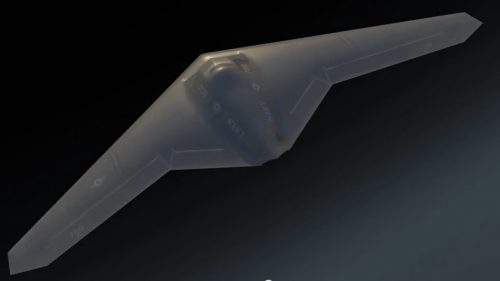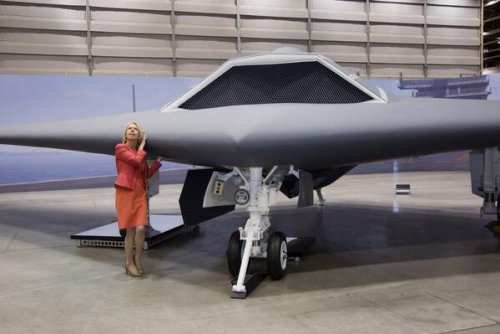The Navy’s Unmanned Carrier Launched Airborne Surveillance and Strike (UCLASS) effort is being retooled as primarily a carrier-based unmanned aerial refueling platform as part of several Pentagon naval aviation mandates as part if the the service’s Fiscal Year 2017 budget submission, USNI News has learned.
The shift from UCLASS to the new Carrier Based Aerial Refueling System (CBARS) will be made alongside an additional buy of Boeing F/A-18 E/F Super Hornets over the next several years and accelerated purchases and development of the Lockheed Martin F-35 Lighting II Joint Strike Fighter (JSF).
The trio of budget moves seeks to blunt the Navy’s looming strike fighter shortfall, move more stealth capability sooner into the carrier air wing and create a development path for future unmanned systems onboard the service’s fleet of nuclear carriers, according to the rationale the Pentagon put forth to the service several defense officials told USNI News.
The budget submission – in part informed by the Pentagon’s UAV strategic program review (SPR) led by Deputy Secretary of Defense Bob Work – will also include 15 F-35C JSFs in 2017 and plan for an additional 14 Super Hornets in FY18, USNI News undersatnds.
“That study found that you need a mix of all of these things,” a defense official told USNI News on Monday.
USNI News understands there may also be efforts to accelerate developments of the Block 3F JSF software – now slated to reach initial operational capability in August 2018 and the major barrier for the Navy to regularly deploy F-35Cs.
The revelation of the budget mandates also comes mere days after the Navy kicked off the Analysis for Alternatives for its next generation air dominance platform – also known as F/A-XX. The program or programs that will replace the capability of the Super Hornets in the early 2030s.
Last year, Secretary of the Navy Ray Mabus said the F-35C would be “almost certainly will be, the last manned strike fighter aircraft the Department of the Navy will ever buy or fly,” he said in address at the Navy League’s 2015 Sea-Air-Space Exposition.
Mabus later said UCLASS was to act as the bridge to autonomous unmanned strike platforms and predicted “whatever F/A-XX looks like — it should be unmanned,” he said in May.
UCLASS
The latest Pentagon direction for the fate of UCLASS changes the character of the program from the Navy’s intended information, surveillance and reconnaissance (ISR) platform that would patrol while the rest of the carrier air wing was at rest, to an aircraft that will actively operate with the air wing.
The ISR-centric UCLASS concept superseded the Navy’s earlier 2006 naval unmanned aerial combat system (N-UCAS) deep strike aircraft concept that sought to extend the lethal range of the carrier into contested environments.
The shift in character for from N-UCAS to UCLASS upset some in Congress to the point that last year’s National Defense Authorization Act set aside “$350.0 million for continued development and risk reduction activities of the Unmanned Combat Air System Demonstration (UCAS–D) aircraft that would benefit the overall UCLASS program, and $375.0 million to be used for a competitive prototyping of at least two follow-on air systems that move the Department toward a UCLASS program capable of long-range strike in a contested environment,” according to the joint statement on the legislation.
Its unclear if the new CBARS will build off the FY 2016 NDAA funds or make a new request as part of the budget. UCLASS had planned to enter the fleet by 2022 or 2023.
In developing the new effort, Naval Air Systems Command will split CBARS into three efforts, developing the UAV airframe, the control system and the communications “connectivity segment,” with the Navy acting as the lead systems integrator.
NAVIAR spokeswoman Jamie Cosgrove would not confirm any details on the CBARS program ahead of the release of the FY 2017 budget next week when reached by USNI News on Monday.
One defense official told USNI News the Navy’s priority would be to develop and perfect the control and the connectivity systems with the idea being those basic systems could be used to on different carrier based airframes.
“The Navy has already said it wants to develop the airframe iteratively and that the most expensive part of the [development] is creating a system for an aircraft to move on, off and around the carrier,” one defense official told USNI News on Monday.
The CBARS airframe – which will take the place of UCLASS as the first operational, carrier-based UAV – will likely be built in a highly efficient wing-body-tail configuration that will limit its ability to strike in contested airspaces.
However, USNI News understands the NAVAIR development scheme could allow for the development of additional airframes that would allow a shape with a lower radar cross section (RCS) – like a delta wing or a so-called “cranked kite” design like Northrop Grumman’s X-47B to use the same control system.
Still, the requirements for the tanking mission put wing-body-tail designs developed by Boeing and General Atomics more inline with the CBARS mission as opposed to offerings from Lockheed Martin and Northrop Grumman which focused on developing aircraft that would be better suited in operating in a more contested air space.
Last month Chief of Naval Operations Adm. John Richardson held visits with all the companies that have submitted proposals for UCLASS as part of a broader effort to learn more about the potential of unmanned systems beyond the UCLASS program, a Navy official confirmed to USNI News.
Tanking
Putting the UCLASS effort toward aerial refueling is by no means a new idea. As early as 2014, industry and defense sources told the USNI News the tanking mission was high on the Navy’s list for UCLASS uses.
The Navy has long complained about the strain its Super Hornets are put under performing the tanking mission. Estimates provided to USNI News indicate 20 to 30 percent of Super Hornet sorties are tanking missions.
Despite the fatigue on the platform, the Navy has not sought to develop a new way to tank planes in a program of record before CBARS. For examples, the service has no plans to explore refueling aircraft from its planned Bell-Boeing V-22 carrier onboard delivery aircraft even though the Marines have a capability to refuel F/A-18s with their own MV-22 Ospreys.
USNI News understands the Navy commissioned a study last year with the Center for Naval Analysis that found that modifying the existing UCLASS program was more capable and cost effective than a modified V-22, Northrop Grumman E-2D Advanced Hawkeye, bringing back the retired S-3 Viking or using the JSF.



